DR-LL Gan: Diabetic Retinopathy Lesions Synthesis using Generative Adversarial Network
DOI:
https://doi.org/10.3991/ijoe.v18i03.28005Keywords:
Diabetic retinopathy, Diabetic Macular Edema, GAN, DCNN, DLAbstract
— Diabetic Retinopathy (DR) is a serious consequence of diabetes that seriously impact on the eyes and is a leading cause of blindness. If the lesions in DR arise in the central portion of the fundus, they may result in significant vision loss, which we refer to as Diabetic Macular Edema (DME). Deep learning (DL) techniques are commonly used utilized in ophthalmology for discriminative tasks such as diabetic retinopathy or age-related macular degeneration (AMD) diagnosis. Deep learning techniques typically need huge picture data sets for deep convolutional neural networks (DCNNs) training, it should be graded by human specialists. According to international protocol, it is classified into five severity categories. However, improving a grading model for high generality needs a significant quantity of balanced training data, which is challenging to obtain, especially at high levels of severity. Typical techniques for data augmentation, in many applications of deep learning in the retinal image processing domain, the difficulty of access to huge annotated datasets and legal concerns about patient privacy are limiting issues. As a result, the concept of creating synthetic retinal pictures that are indistinguishable from actual data has garnered more attention. GANs have been certain to be an effective framework for creating synthetic databases of anatomically accurate retinal fundus pictures. GANs, in particular, have garnered increasing attention in ophthalmology. in this article, we present a loss-less generative adversarial network (DR-LL GAN) to generate good resolution fundus pictures that May be adjusted to include random grading and information about the lesion. As a result, large-scale generated data may be used to train a DR grading and lesion segmentation model with more appropriate augmentation. Our model experiments evaluated on IDRID and MESSIDOR datasets, it's obtained a discrimination loss of 0.69374 and a generation loss of 1.10438, as well as a segmentation accuracy of 0.9840 in our tests. This might support in the optimization techniques of the neural network design and in computer-aided screening of medical picture, thus increasing diagnostic reliability for clinical assessment in the future of sophisticated technological healthcare.
Downloads
Published
How to Cite
Issue
Section
License
Copyright (c) 2022 Saif Hameed Abbood, Haza Nuzly Abdull Hamed, Mohd Shafry Mohd Rahim, Haider Th.Salim Alrikabi, Abdul Hadi M.Alaid

This work is licensed under a Creative Commons Attribution 4.0 International License.


